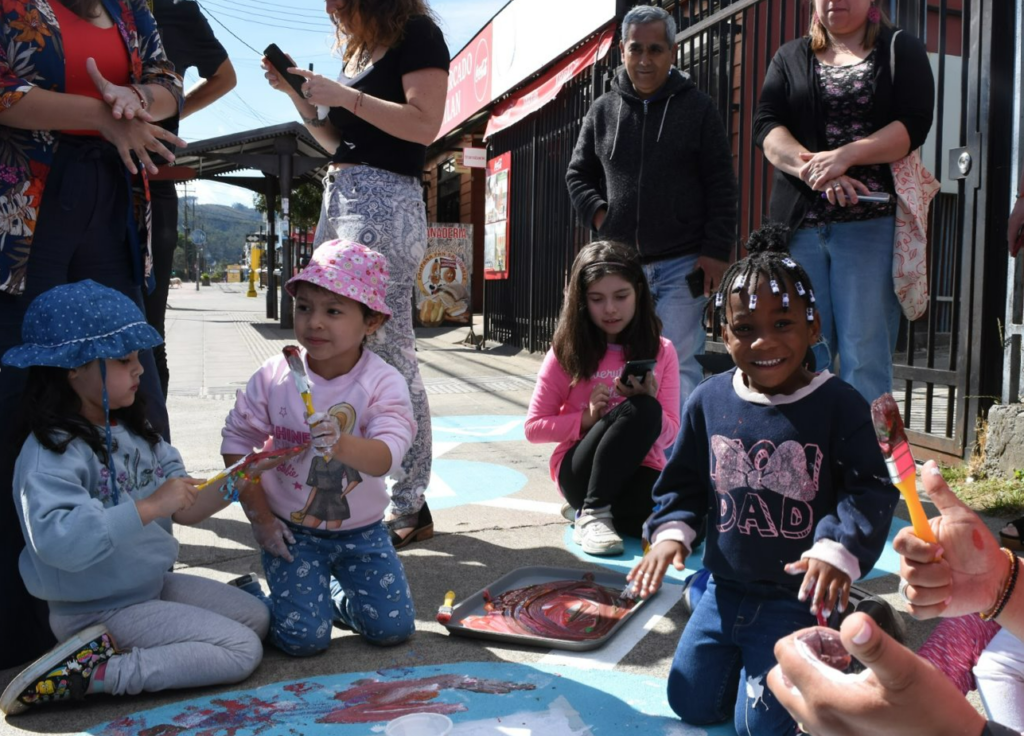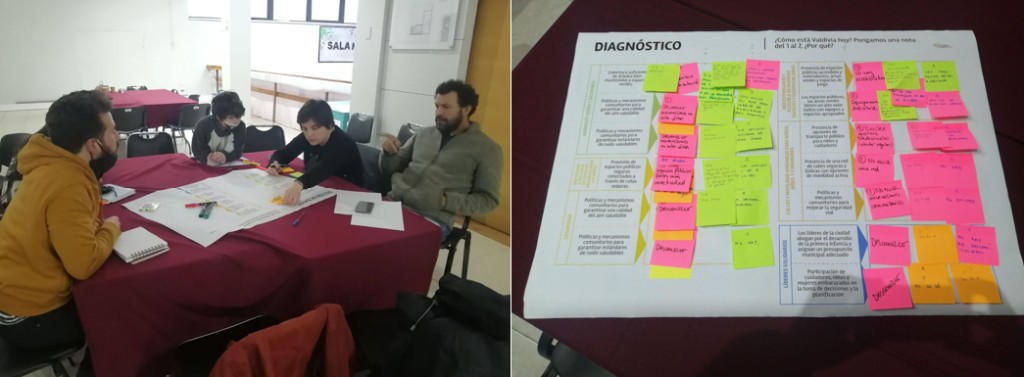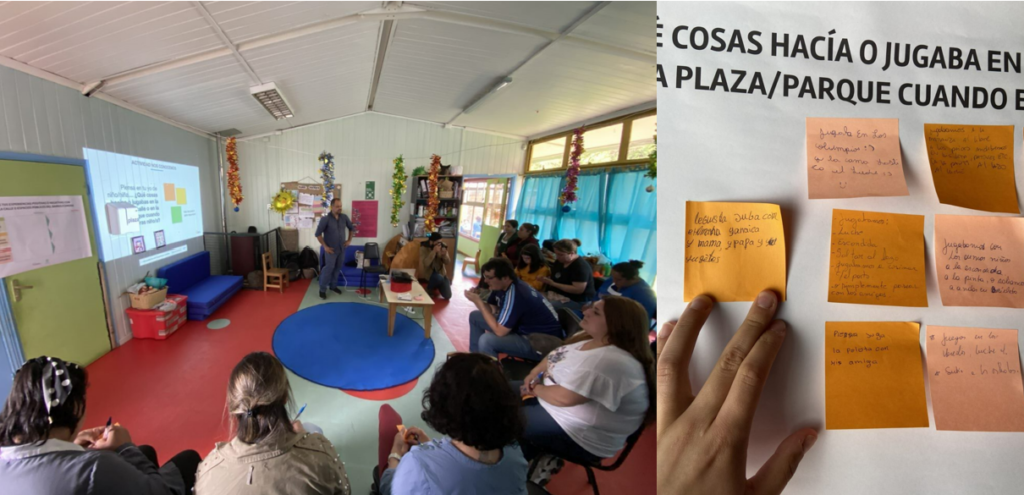
Overview
Location:
Validivia, Chile
Organisation:
Ciudad Emergente
Partner organisations:
City of Validivia
Year:
2022
Scale of proximity:
Neighbourhood
Target beneficiaries:
Children 0-5; Caregivers
Building safer and more supportive spaces for children
How can we reimagine crowded and car-filled streets as safe and supportive spaces for children? This is the question we set out to address in our project Valdivia Neighbourhood of Care. Our project is focused on a busy road called Avenida Argentina, located in a neighborhood within the city of Validivia, Chile, with a high concentration of children, three schools and a kindergarten, without any safe spaces to play. To develop this intervention, the Ciudad Emergente team is building on our experience in urban design and architectural interventions across over 400 projects in 10 countries. In everything we do, our key aim is to put people at the center of sustainable development through social innovation and collaboration.
Understanding the needs of young children and caregivers
The Proximity of Care Design Guide provided us with a framework to analyze the environment in which the project was going to take place. It also enabled us to consider how stimulating the built environment could be for young children and gave us a new perspective on how we were going to achieve our goals. For example, when talking about stimulation, being able to think about whether the street was inviting, with opportunities and playgrounds for small children to play in or explore.
To make sure we understood the needs of the community we’re supporting, we held a workshop with the municipality and focus groups with kindergarten teachers. These sessions were really valuable in creating the opportunity to transfer knowledge and tools to the city staff and help them implement some of the assessment and design activities.

Workshops were run with the local municipality to transfer knowledge and tools in designing cities for young children and their caregivers.
Understanding the needs of small children and how they experience their city was not as straightforward as having a conversation with older children or adults. Instead, we developed a new methodology, using storytelling to encourage them to imagine how they would transform their city.

A storytelling methodology was developed to inspire young children to imagine how they could transform their city
With guidance from these sessions and surveys disseminated to parents and caregivers, we developed a concept design remodeling the kindergarten play area and transforming the nearby street, Avenida Argentina. These sessions were also integral in helping us understand the challenges we had to address. For example, with the focus group we learnt how trucks disrupt childrens’ sleep and how they’re walking on the street less because of the traffic. In our conversations with the local community, we often found that there was a disconnect with caregivers imagining their city as a space that can impact their children’s development, as these weren’t interactions with the city that they had experienced growing up.

Workshops with caregivers helped to identify the challenges and opportunities of the local area for their children and themselves.
Another aspect of the Proximity of Care guide that stuck with us was this idea of “behaviors” – thinking of our project in terms of the actions that we want to promote and what behaviors might encourage healthier lifestyles and better outcomes for young children. This helped us redefine the objectives of our project and what we want to achieve with the children and caregivers we are supporting. Not only thinking about toddlers as a target group, but also on encouraging positive behaviors, such as reducing disturbances to sleep caused by the sound of trucks driving through the neighborhood. We’re also encouraging children to play in the streets more, by providing a quality playspace that children in the local area are lacking.
Designing an intervention that is both safe and stimulating
We wanted to address our identified challenges by transforming the space to create a safer, healthier and more stimulating environment. To achieve this our design aimed to protect pedestrian spaces from cars by widening pavements, raising pedestrian crossings and rerouting trucks and traffic from Avenida Argentina. It also incorporated the design of more stimulating environments by adding vegetation along the road, creating new playgrounds and resting places for children and their caregivers to socialize.
A priority for the project is also improving road safety with a street design that reduces car speeds, by raising crossings and clears pavements to better accommodate pedestrians and by blocking cars from parking on pavements and aiming to reduce noise by changing the routes of trucks.

The main intervention sites and strategies along the Avenida Argentina road prioritise safety and the creation of stimulating, playful spaces.
The impact and influence that advocates can have on a design project
Finding partners that can assist with the project’s work also makes an enormous difference. In our case it was the municipality who partnered with us to implement many of the activities; having a champion on your side is always of great help for a project of this nature. Creating opportunities to gain feedback from a wider audience also informed us of the need to develop new metrics to measure the impact of our project. For example, the need to improve the community perception of the public space and the quality of play equipment in playgrounds.
We have also developed multiple strands of activity to engage local and regional support, firstly creating a video to explain our project, how they can support and highlight the need for funding. The goal is that with the video and the masterplan to redesign Av. Argentina, we can continue working with local and regional authorities to create temporary interventions, refine and implement the final design. This can be an example for all of Chile on how to develop a process to transform urban environments with toddlers and children in mind. Secondly, we’re holding a conference to launch the project and demonstrate how we’ve refined the design.
When we look ahead to what success for our project could look like, we believe we will have succeeded if we;
(1) Get more young children and their families to feel safer and walk more within their neighborhood,
(2) Encourage caregivers to play more with their children on the streets and playgrounds,
(3) Encourage active contribution from children and caregivers into improving their local area.
Reflections on the Proximity of Care Design Guide
One of the main lessons we learnt from the Proximity of Care Design Guide when developing our project was how to incorporate young children aged 0-5 into our vision. We had some experience working with older children, but it was very different and challenging to engage with the capabilities of younger children. Howere we learned how important it was to do so since young children and their caregivers have very different needs from other groups in relation to the built environment, such as wider, obstacle-free pavement and places to rest frequently for small children that can’t walk far.
When working with young children, the Proximity of Care approach has shown our team the value in not only talking to parents and caregivers but also with teachers and educators. They are a group that spend a lot of time with young children with the purpose of helping them develop their skills both physically and mentally.
We believe the Proximity of Care Design Guide is a great tool for local governments to really measure how child-friendly their city or neighborhoods are. If we can use this approach to create a baseline for neighborhoods and cities to evaluate themselves and commit to improvements with young children in mind, then we feel it could change the way we think about our cities and encourage much needed improvements. If cities work for children, and especially young children and their families, we believe they can work for everyone else too.
Links and sources